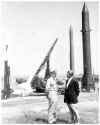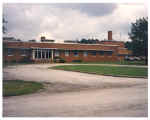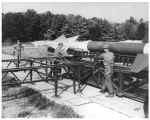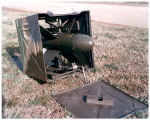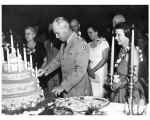1950 - 1952
|
In October 1948, the Chief of Ordnance had designated Redstone Arsenal as the center of research and development activities in the field of rockets and related items. The arsenal was officially reactivated as the site of the Ordnance Rocket Center on 1 June 1949. By the end of that month, Huntsville Arsenal ceased to exist as a separate facility. Later, on 28 October 1949, the Secretary of the Army approved the transfer of the Ordnance Research and Development Division Sub-Office (Rocket) at Fort Bliss, Texas, to Redstone Arsenal. Among those transferred were Dr. Wernher von Braun and his team of German scientists and engineers. With the arrival of the Fort Bliss group beginning on 15 April 1950, Redstone Arsenal officially entered the missile era. The various chronological entries have been extracted from arsenal records from the 1950-55 period, newspapers of that time, personal recollections, and various other sources found in the Historical Office's archives. Many of the photographs included in this volume correspond to a particular event described in an entry. Others are representative of the various activities that occurred. The period dating from January 1950 to August 1962 was time of outstanding success for the U.S. Army's rocket and missile programs. It was also the period during which the Army made its most notable contributions to the nation's space effort. The pursuit of excellence that characterized Redstone Arsenal during World War II continued throughout the 1950s and 1960s. It remains the hallmark of today's Redstone Arsenal. January 50 A plan for the construction of 120 on post housing units under the "Wherry Bill" was formulated and sent to Headquarters, Third Army, where it was approved & forwarded to Washington, D.C. April 50 A Records Management Officer (civilian) was appointed to perform records administration duties on a full-time basis for Redstone Arsenal. Prior to this time, records administration had been an additional duty of the Mail & File Supervisor. April 50 A staff of Army officers, together with about 120 German scientists, arrived from Fort Bliss to make their headquarters at Redstone Arsenal. 1 April 50 Under General Orders No. 19, the Department of the Army (DA) officially discontinued Huntsville Arsenal and consolidated the major portions of its land and facilities with Redstone Arsenal to accommodate the newly transferred Ordnance Research and Development Division Sub-Office (Rocket). 15 April 50 With the arrival of the Fort Bliss group, Redstone Arsenal officially entered the missile era, and 1 year later assumed responsibility for the national procurement and field service missions. In addition to basic and applied research, development, and testing of free rockets, solid propellants, jatos, and related items, the arsenal was charged with research and development (R&D) of guided missiles. 15 April 50 The Ordnance Research and Development Division Sub-Office (Rocket) was redesignated the Ordnance Guided Missile Center after its transfer to Redstone Arsenal. 15 April 50 After this date, some of the buildings located in the northeast section of the arsenal were used as apartments to house members of the original Von Braun rocket team upon their arrival from Fort Bliss, Texas. May 50 The Post Engineer received work orders to reactivate certain buildings, structures, equipment, and machinery in Plants Area 1 and the former Huntsville Arsenal headquarters area to provide facilities for the movement of guided missile activities from Fort Bliss to Redstone Arsenal. Buildings 111 and 112 were converted to laboratories and offices for the Ordnance Guided Missile Center. In addition, Keller Motor Company's lease was canceled and those buildings were assigned to the Ordnance Guided Missile Center. |
|
16 June 50 The first Army chaplain to be assigned to Redstone Arsenal--CPT Willard B. Smith--reported for duty. 25 June 50 North Korean troops armed with Soviet-made weapons crossed the 38th parallel, invading South Korea. The next day, President Harry S Truman authorized the U.S. Navy and Air Force to aid South Korean troops operating south of the 38th parallel. Two days later the United Nations Security Council adopted a resolution calling for armed intervention in Korea. 28 June 50 As directed by the Commanding General, Third Army, the Redstone military reservation was closed to the public. July to August 50 Ordnance directed Redstone Arsenal to study a 500-mile surface-to-surface missile. 1 July 50 The former Huntsville Arsenal became the Chemical Division of Redstone Arsenal. |
|
August 50 A rapid expansion of the ammunition program at Redstone Arsenal was started. This consisted primarily of the accelerated completion of the existing ammunition renovation program and planning for new production of various types of ammunition. |
|
September 50 Redstone Arsenal was directed to study a solid propellant LOKI, an antiaircraft, free-flight rocket approved for development by DA in December 47. |

LOKI |
|
September 50 The OCO directed Redstone Arsenal to study the development of a field artillery rocket, later designated the T237 Field Artillery Rocket, using the gun-launch principle for high accuracy ground-to-ground firings. The arsenal did not receive project implementing instructions until August 51. September 50 With the outbreak of the Korean War, the ammunition programs at Redstone Arsenal were accelerated. Large amounts of additional funds were provided to the arsenal for increased employment & the rehabilitation of facilities. |
|
October 50 A request from the Veterans of Foreign Wars was approved by which Redstone Arsenal would provide a firing squad (known today as the firing team of the honor guard) for military funerals of deceased soldiers returned from the Korean War. 31 October 50 Ordnance Corps General Order No. 5-50 officially redesignated the 9330 Technical Service Unit (TSU), Research & Development Sub-office (Rocket), Fort Bliss, Texas, as the 9330 TSU, Redstone Arsenal, Huntsville, Alabama, effective this date. The same general orders discontinued the 9362 TSU, Redstone Arsenal, and all personnel & equipment assigned to the unit were transferred to the 9330 TSU. December 50 The arsenal was assigned technical supervision of the large caliber field rocket project. At the same time the rocket was given the popular name HONEST JOHN. 7 December 50 The Chief of the Ordnance Corps directed Redstone Arsenal to determine the feasibility of a white phosphorus smoke rocket. The study resulted in a plan for two rockets, but Ordnance suspended the program in early 1952 because the Army Field Forces had no immediate need for such weapons. In March 1952, however, Ordnance instructed Redstone to adapt the rocket for propaganda leaflet dissemination. The arsenal delivered T229 rockets to the Psychological Warfare Center at Fort Bragg, North Carolina, in June 54. 31 December 50 The total personnel strength for Redstone Arsenal jumped to 2,960 (2,400 civilian, 59 officer, 501 enlisted) by this date. This was an increase of 2,240 over figures as of 1 July 49 (709 civilian, 11 military). 1951 The Ordnance Corps expanded Redstone Arsenal's mission to include antiaircraft rockets, and, with Rock Island Arsenal and Picatinny Arsenal, rocket launchers and solid propellants. 1951 Redstone Arsenal had the highest reported number of anopheles quadsimaculatus mosquitoes in the Third Army area. Among the measures taken to combat this problem were aerial sprays; heavy spraying of DDT at all larva points having positive weekly dips; elimination of stagnant water holes and ponds where feasible; and aerosol bombs. Despite the presence of these pests and the region's history of endemic malaria, the only cases of the disease occurring on the installation were found in soldiers who had returned from Korea. January to June 51 Line 5 was lost as an ammunition producing facility in this period, after it was made available to the Thiokol Corporation for research activities. To meet an anticipated acceleration in its production schedule, the Ammunition Division proposed that Line 5 be replaced by a group of buildings being used as an automotive maintenance shop. These buildings were rehabilitated for the manufacture of medium caliber chemical ammunition. Known as Line 8, the renovated facility was capable of producing 600,000 rounds per month. February 51 The Office of the Chief of Ordnance and the Chief of the Army Field Forces approved Redstone Arsenal as the site for guided missile courses. February 51 Redstone Arsenal received official notification that it was a Class II installation with permanent status and was directly responsible to the OCO. February 51 Army Ordnance awarded Cornell Aeronautical Laboratory a formal development contract for the LACROSSE missile system. |
|
19 March 51 The firing squad, bugler, and pallbearers from the 3523 Area Service Unit (ASU) participated in the military funeral of the first Korean war casualty returned to Madison County, Alabama. 2 April 51 Recruiting tours in adjoining states to find required technical and professional personnel began on this date. Four recruiting teams traveled to 25 cities in Alabama and Tennessee over a 2-week period and interviewed about 925 applicants. 29 June 51 The first round of five feasibility demonstration flight tests of the Basic M31 HONEST JOHN system were fired at White Sands Proving Ground. Results of the five-round demonstration, which ended 7 August 51, established the technical feasibility of the basic HONEST JOHN as a highly accurate system. July 51 Following the United States' entry into the Korean War, four ammunition lines at Redstone Arsenal were reactivated from standby status and resumed production. July 51 Redstone Arsenal was notified that Huntsville had been classified as a critical defense area in June 51. As a result, Regulation "X" on credit restrictions for housing was lifted. A total of 600 housing commitments, including rental and purchase units, was authorized. |
|
July 51 to July 56 Over 38.7 million complete rounds of chemical artillery ammunition were produced at Redstone Arsenal. By the end of 1955, the installation was producing a major portion of all chemical artillery ammunition used by U.S. armed forces. 10 July 51 The OCO formally transferred the responsibility for conducting the R&D phase of the HERMES Cl project to Redstone Arsenal. |
|
17 July 51 Redstone Arsenal released the initial CORPORAL I production
letter contract to the Firestone Tire and Rubber Company.
|

CORPORAL |
|
August 51 Redstone Arsenal provided test and data reduction facilities, as well as supervised Thiokol's motor loading facility, for the T212 (later the T262) High Explosive, Anti-Aircraft Rocket program supervised by the OCO. The project was phased out between late 1956 and early 1957. 2 August 51 The Secretary of the Army approved formal full-scale development of the basic HONEST JOHN weapon system. 3 August 51 COL Carroll D. Hudson, Commanding Officer of Redstone Arsenal, presented the highest decoration granted by DA to a civilian employee at a ceremony attended by about 100 key personnel. James A. Cantrell, a radio repairman, received the award for bravery in saving the life of a drowning MP on 30 March 51. The soldier was directing traffic away from the hazardous side of Redstone Road after flood water backed up from the Tennessee River to the main arsenal entrance. The MP accidentally fell into the surging water and was swept through a culvert under the road before being rescued. 3 August 51 The Technical and Engineering Division was established at Redstone Arsenal. Major elements of this division were the Rocket Development Group, the Guided Missile Development Group (a direct descendent of the group established at Fort Bliss in 1946), and the Engineering Development Group. The division's Technical Library maintained all reports relative to R&D activities in addition to operating a reading room and reference library for R&D personnel. 6 August 51 The Office, Director of Projects was formally established at Redstone Arsenal to direct and coordinate all guided missile and rocket projects involving two or more divisions. Aware that the arsenal suffered from an extreme shortage of experienced personnel able to direct the installation's newly assigned missile activities, the Commander concentrated experienced military guided missile personnel in this office where maximum overall use could be made of their expertise. The office was discontinued on 29 October 52. 16 August 51 The Chief of Ordnance delegated to Redstone Arsenal responsibility for coordinating the research and development of the CORPORAL surface-to-surf ace missile program. Technical supervision of the overall program rested with the Jet Propulsion Laboratory until 1955, when Redstone assumed this mission. The CORPORAL, research on which had begun in 1936, evolved through several stages until September 49, when Ordnance decided to modify the CORPORAL E version to fill the requirement for an interim guided missile system called the CORPORAL Type I. |
|
7 September 51 After release of an Army Field Forces requirement for a ground-to-ground rocket weapon system to disseminate chemical agents (the T238 Area Toxic Rocket weapon System), Ordnance contracted with Arthur D. Little, Inc., to study and develop such a weapon. Redstone served as technical supervisor of the project, which later transferred to ARGMA. October 51 Redstone Arsenal began development of aerial towed targets. October 51 In accordance with an OCO directive, a Contract Review Board composed of Huntsville residents was appointed to examine all Redstone Arsenal contracts above $100,000. Included on the board as part-time employees were M.B. Spragins, president of the First National Bank; Karl A. Woltersdorf, manager of the Huntsville Electric System; W.T. Galloway, president of the Chamber of Commerce; and Reese T. Amis, editor of The Huntsville Times. 8 October 51 The Redstone Arsenal Institute of Graduate Studies was established. It was set up on a contractual basis with the University of Alabama. The overall goal of the program was to promote the effectiveness of the rocket and guided missile programs by improving the technical training of military and civilian personnel through refresher courses, seminars, and graduate studies. 15 October 51 The Projects Branch began actively following the progress of the TERRIER program in anticipation of technical supervisory responsibility being transferred to Redstone Arsenal. 11 November 51 A Redstone Arsenal firing squad participated in a memorial service at the Maple Hill Cemetery in Huntsville at which a monument was dedicated to deceased veterans of World War II and the Korean Conflict. 15 November 51 The first successful NIKE guided missile firing was conducted against a ground target. 27 November 51 The first successful demonstration of a complete NIKE guided missile was made against an airborne target. This was the first successful engagement of an air target by an antiaircraft command-guided missile system. 28 November 51 The Redstone Federal Credit Union was chartered. 6 December 51 CORPORAL E Flight 11 was the second U.S. missile to have the delta fin configuration, the basic pattern of the tactical CORPORAL, and the first to carry elements of the warhead equipment. Prototype Doppler radar and computer equipment were also employed on this flight. 10 December 51 A contract for 200 Type I CORPORAL missiles, spare parts, and documentation was awarded to Firestone, the first such contract executed in the United States. 15 December 51 A utility sale contract was initiated between the Government and the Algonquin Alabama Chemical Company. Two chlorine plants formerly leased to the Solvay Process Division of the Allied Chemical & Dye Corporation, were out leased to Algonquin for 10 years and subject to renewal for three additional periods of 5 years each. The estimated annual sales under this contract totaled $550,000. January 52 A combined NIKE and CORPORAL Direct Support Company was approved. The CORPORAL section was later designated the 96th Ordnance Direct Support Company, CORPORAL and was the first company of this type to go overseas. 9 January 52 The remainder of the HERMES project was transferred to Redstone Arsenal. Although most of the HERMES project was terminated by 1954, the HERMES Cl study formed the basis for early REDSTONE missile research. |
|
February 52 The Redstone Rocket, a civilian weekly newspaper, began publication. |
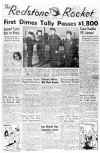
Redstone Rocket |
|
1 February 52 An advance party of two officers and two enlisted men reported to Redstone Arsenal on permanent change of station to coordinate with arsenal authorities on various housekeeping details before the arrival of the main group from Aberdeen Proving Ground. This action was taken in anticipation of the opening of a new ordnance school at Redstone Arsenal. 15 February 52 The Josiah C. Gorgas Laboratory, located on Redstone Road, was dedicated at Redstone Arsenal. Named for the Confederate Chief of Ordnance, the $1.1 million solid rocket propellant research and administration plant was turned over to Rohm & Haas, the contractor, after the formal dedication ceremony. March 52 Three CORPORAL battalions were activated, the United States' first ballistic missile units. Provisional Redstone Ordnance School 3 March 52 The Commanding Officer at Redstone Arsenal, COL Carroll D. Hudson, officially established the Provisional Redstone Ordnance School (PROS). Colonel Hudson became the first commandant of the school, the forerunner of the full-fledged Ordnance Guided Missile School (now the Ordnance Missile and Munitions Center and School). 10 March 52 The first class at the Provisional Redstone Ordnance School--the Guided Missile Officer course--began with seven students. 10 March 52 The CORPORAL and NIKE systems shared honors in the initiation of the first guided missile training program begun at Redstone Arsenal. 29 March 52 A tornado ripped across north Alabama, crossing the southeast corner of Redstone Arsenal. Although the storm left at least four people in the state dead and numerous others injured, none of the arsenal's personnel were hurt during the storm. Production Line #6 sustained about $80,000 in damage. |
|
1 April 52 The OCO disapproved Redstone Arsenal's proposed development plan for what would become the REDSTONE missile. The arsenal had intended to implement the manufacturing program for these missiles by creating an assembly line in its own development shops. The OCO, however, required that a prime contractor handle the development effort. Nevertheless, delays in acquiring production facilities for the contractor caused the arsenal to fabricate and assemble the first 12 REDSTONE missiles along with missiles 18 through 29. |
|
8 April 52 Known by various names such as HERMES Cl, MAJOR, URSA, XSSM-G-14, and XSSM-A-14, Ordnance assigned the popular name REDSTONE to the system. |

REDSTONE |
|
May 52 The OCO directed Redstone Arsenal to study the potential of an improved, lightweight, antitank rocket which could be shoulder fired. In February 53, the arsenal reported that such a system was feasible. On 15 June 54, Ordnance assigned Redstone responsibility for technical control and supervision of the T266 High Velocity Antitank Rocket program. It was terminated in 1956. May 52 The first class was graduated from the Provisional Redstone Ordnance School. May 52 Redstone Arsenal began a feasibility study of an improved version of the NIKE I. |
|
June 52 Redstone Arsenal began developing aerial target drones. 16 June 52 Douglas Aircraft Company received the initial limited production contract for the basic HONEST JOHN. 20 June 52 The Office of the Chief of Ordnance assigned Redstone Arsenal complete responsibility for the preparation of Ordnance technical publications. July 52 The rehabilitated Line 6, damaged by a tornado in March 52, was put back into production. July 52 The first civilian students were trained by the Provisional Redstone Ordnance School during this period. July to September 52 The impact of the national steel strike continued to escalate throughout July and August, becoming most critical in September. The strike began in June 52 after the Supreme Court declared unconstitutional President Truman's attempt to take over the steel industry. In order to meet requirements, it was necessary to send buyers on the road to call on warehouses and mills to buy steel on-the-spot wherever it could be located, since the usual method of purchase was not effective. 1 July 52 The OCO assigned Redstone Arsenal responsibility for research and development of the TERRIER, a Navy-developed antiaircraft guided missile. The Army planned to used the TERRIER as an interim weapon until the NIKE I (AJAX) became operational. After NIKE development bypassed the development of a suitable ground control system for this ship-launched missile, Ordnance transferred its TERRIER ground equipment to the Marine Corps. 1 July 52 The German scientists and technicians at Redstone Arsenal who entered the United States through Project Paperclip were converted from DA Special Employees to Civil Service. With the exception of three employees, all of the Germans working at the arsenal were able to meet the eligibility requirements for conversion. Those ineligible at that time continued working under personal services contracts. This action served to reduce problems connected with the administration of personal services contracts and security clearances. 1 August 52 Redstone Arsenal General Orders #18 established a Troop Command effective this date. The command provided discipline, housing, administration, messing, training, and support supply for all military personnel assigned to Redstone Arsenal. 26 August 52 The Chrysler Corporation was accepted as the prime contractor for the REDSTONE project. |
|
September 52 Two 18-foot cruisers were placed into service to patrol the arsenal's southern boundary along the Tennessee River. |

Patrol Boats |
|
18 September 52 The Technical & Engineering Division was redesignated as the Ordnance Missile Laboratories (OML) to plan, direct, perform, and coordinate research and development as well as product engineering on mission items and tasks within the field of guided missiles, jatos, and rockets. This change was part of a general reorganization of Redstone Arsenal. Also, the division's Rocket Develop Development Branch (formerly the Ordnance Rocket Center) became the Rocket Development Laboratories of OML. 28 September 52 The industrial lease of John Powell & Company, Inc., for the north half of Building 781 was terminated. The company had used the space for chemical manufacturing. October 52 The Chrysler Corporation was issued a letter order contract to proceed with active work as the prime contractor on the REDSTONE missile system. This contract was definitized on 19 June 53. October 52 The last shipment of vehicles under the Special Vehicle Project was completed thereby phasing out this program. During the time this project was in operation about 7,000 vehicles and trailers had been received, stored, maintained, and shipped. 7 November 52 An explosion occurred in the experimental mixer bay of Building L-555 operated by the Rohm & Haas Company. The blast inflicted an estimated $3,671 in damages to the building and its equipment, but workers inside at the time escaped without injury. |
|
1 December 52 Redstone Arsenal lost jurisdiction over the Provisional Redstone Ordnance School, when the latter was established as the Ordnance Guided Missile School (now the Ordnance Missile and Munitions Center and School), a Class II activity under the Chief of Ordnance. However, the school continued to depend on the arsenal for administrative and logistical support. 31 December 52 Only 10 months after the activation of the first class, the Ordnance Guided Missile School (OGMS) had processed a total of 1,182 students (1,113 military; 69 civilian). |
The Redstone Arsenal Era: Introduction, 1950 - 1952 , 1953 - 1955
